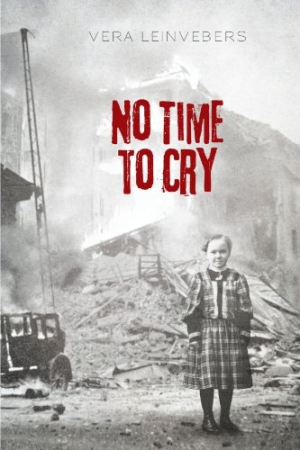No Time to Cry
In her memoir No Time to Cry, Vera Leinvebers relates the harrowing tale of her childhood during World War II and its aftermath. Her tale is difficult and agonizingly sad, but beautifully told in prose that borders on the poetic. Exquisite in their presentation, her insightful descriptions and portrayals are decidedly mature. In question is whether the perceptions are those of the author as a child, as she maintains, or whether perspective gained in the years since the events took place might not also be entwined with her recollections. Either way, Leinvebers writes dramatically and with obvious passion.
“No matter how much one might suffer, when the goal is to survive there is simply ‘no time to cry,’” Leinvebers states, explaining the title of her book. Her story starts in 1944, when, at the age of six, she is forced to flee her Latvian homeland as the threat of Soviet invasion looms. What follows is a complex chronicle of her family’s experiences with displacement, continued flight, violence, starvation, and horror as they fight to reach safety. The young girl witnesses gruesome acts of cruelty and brutality. Bombings, massacres, and extreme personal hardships leave her traumatized “beyond repair, permanently destroying [her] childhood innocence.” Determined perseverance throughout is the solid theme that carries both the child and the story itself forward through to the present day.
Those unfamiliar with Latvia and its fate during WWII and the Soviet era may need some guidance in reconciling exactly what is happening to families like Leinvebers’s, and why. The author never reveals much about the Latvian situation or its background, and she rarely mentions any dates, so readers may find themselves confused about how her personal situation fits into the overall history of the war. It would be helpful if she included even a brief timeline highlighting relevant events.
Because her narrative relates so much turmoil and so many horrific incidents, the plot often seems a bewilderingly chaotic jumble, much as the war itself must have seemed to the young Leinvebers. Effective as her storytelling strategy is in setting the appropriate tone, it also may be perplexing to those who are not aware why the family is fleeing, where they are going, or over what period of time their ongoing flight takes place.
The author credits her parents with instilling the values that allow her to survive and to respect life and the gifts it offers. The extent of her bravery is astonishing, and her introspection thorough; she seems to remember everything. She speaks affectionately of individuals who unexpectedly share a bit of tenderness during her most difficult times: a kind German officer who helps her, a Danish priest who buys her her very first ice cream cone, numerous Red Cross workers who go above and beyond to help, and several others, including many whose names she never learns. All share a permanent place in her heart, thanks to their generosity. “Compassion and benevolence” from a select few ultimately change her life, and, despite the desolation of her youth, she emphasizes instead her message of tolerance, appreciation, and kindness.
No Time to Cry is an eloquent, engaging memoir, sure to please any number of discriminating readers. Knowing some Latvian history will assure an easier understanding of Leinvebers’s plight and add historical depth to her story.
Reviewed by
Cheryl Hibbard
Disclosure: This article is not an endorsement, but a review. The publisher of this book provided free copies of the book and paid a small fee to have their book reviewed by a professional reviewer. Foreword Reviews and Clarion Reviews make no guarantee that the publisher will receive a positive review. Foreword Magazine, Inc. is disclosing this in accordance with the Federal Trade Commission’s 16 CFR, Part 255.

